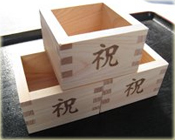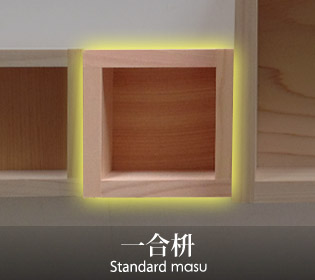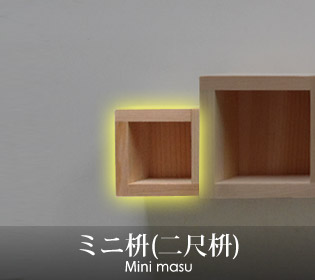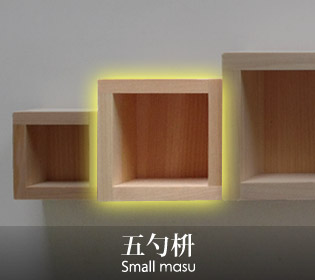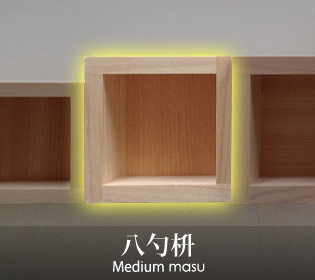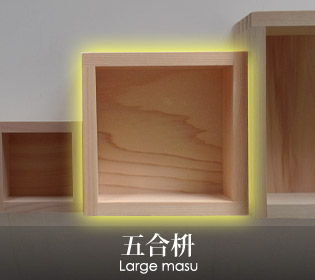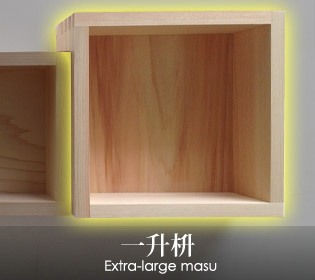



Please let us introduce these plain masu cups that don't have any designs on them. Thanks to not being branded, we can offer you these plain masu cups cheaper than what the custom branded masu cups would cost.
Currently plain masu cups are available in 6 different sizes:
Mini masu (Mini masu)
Small masu (Small masu)
Medium masu (Medium masu)
Standard masu (Standard masu)
Large masu (Large Masu)
Extra-large masu (Extra-large masu)
Tell us if you are looking for a size other than these, we will use our extensive network of partner companies to try to get you the size that you need. Feel free to contact us anytime!
Their difference in size is very distinct when all 6 types of plain masu cups are lined up like this:
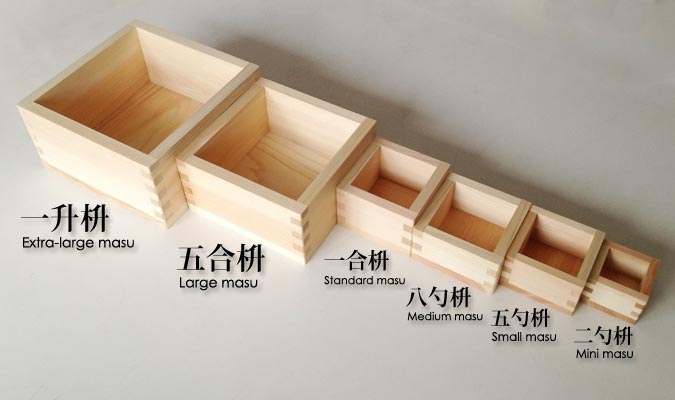
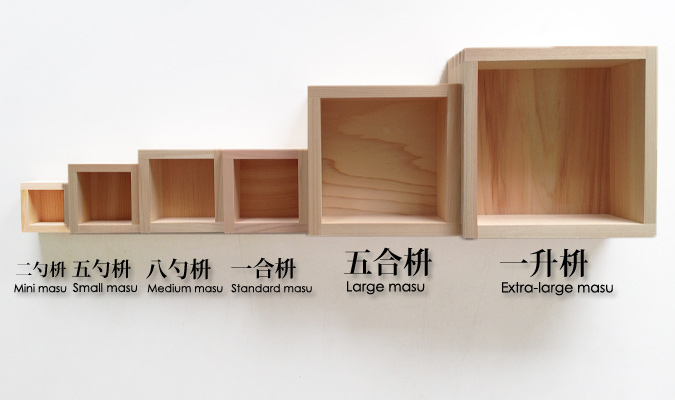
As you can see, we have many types of plain masu cups you can choose from.
Please select the one(s) that are the most appropriate for your purposes.

-
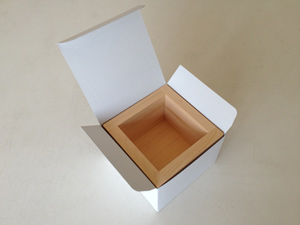
A simple, nice paper box for protecting the masu cups from scratches.
It's also very useful if you would like to use the masu cups as a gift to someone. -
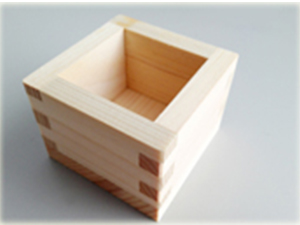
Order a transparent, stringed plastic bag for each of your freshly purchased masu cups.
These bags are perfect for people who would like to take their masu cups home they have used them.

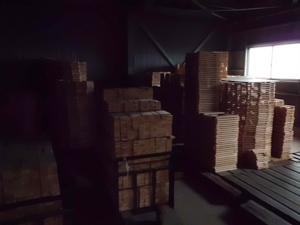
Air drying
The lumber that’s used for manufacturing masu cups undergoes a process of natural drying either indoors for a maximum of 4 months or outdoors for maximum of 1 month depending on both the quality,
condition of the hinoki wood and the weather of the actual season as well. The goal of the drying the hinoki is to decrease the moisture content of the wood to a level that is appropriate for the manufacturing process.
The gist of the process is to create a stack of the lumber on raised foundations and dry it gradually with a continuous flow of air.
The loss of moisture inevitably causes the shrinkage of the hinoki wood, so it needs to be controlled with care as too rapid drying may lead to damaging the wood. If the lumber is considered dried,
then it’s ready for manufacturing.
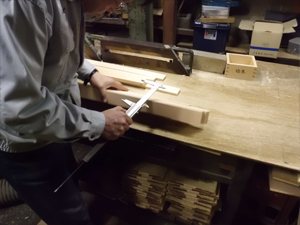
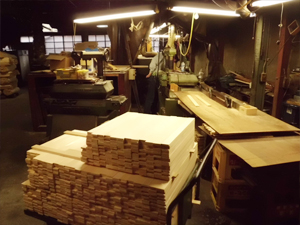
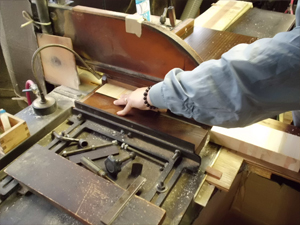
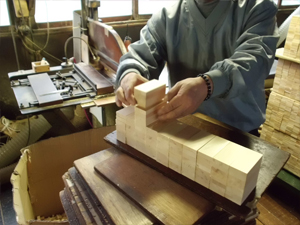
Cutting
In this step, the lumber is cut into pieces of uniform size and shape by a machine that also shaves both sides of the lumber thoroughly. Each and every piece is checked for any faults like wood knots, deformations etc.
and these faulty pieces are removed before sending them to the next manufacturing phase. Hinoki (Japanese Cypress) is a relatively expensive wood.
Throughout the whole cutting process craftsman aim to leave as low waste as possible since they would like to offer their products on a low price and they would like to be ecologically conscious too.

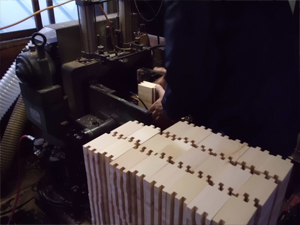
Joinery
After cutting the parts of the masu cups into the right sizes and shaving them nicely, the joinery work starts, finger tenons are cut into all of them for joining together all four sides of the masu cups.
The cutting edge of the tenon cutter machine is polished every day for keeping it as sharp as possible, since this helps to make the quality of the masu cups especially good.
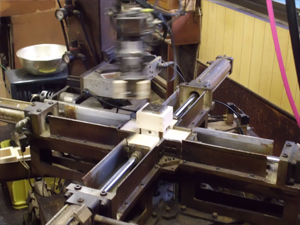

Frame assembly
The tenons of the sides of the masu cups are first glued with an adhesive that’s harmless to the human body after dried, and then these side pieces are placed into the frame assembly machine that presses all 4 sides together.
Next the frame is checked again visually for any kinds of faults like the assembled frame being too frail, wood knots etc. and these defected pieces are removed from the production. Checking is a vital part of every production step.
Concerning the safety of the adhesive used in the production, we have 2 safety certifications: one is issued by JFRL “Japan Food Research Laboratories”
http://www.jfrl.or.jp/e/ and the other one is issued by JCII “Japan Chemical Innovation and Inspection Institute”
http://www.jcii.or.jp/en/ both documents are in Japanese. Please contact us if you would like to acquire the English versions of any of these documents.
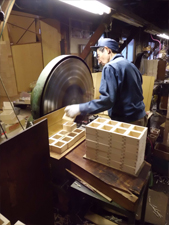
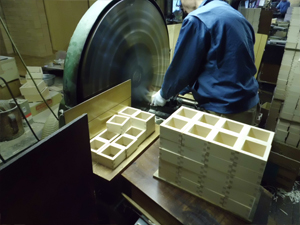
Planing
All the surfaces of the assembled frames are leveled using a so-called “planer disk”, the machine displayed above.
In this step, Japanese craftsmen don’t need to take a look at the masu frames; they know exactly when the surfaces of the frames are perfect by the slight change in the sound of the planing.
After the frames are planed, the bottom of the cups is glued to the frames to make the masu cups complete. Besides paying attention for the surfaces, the craftsmen take care to produce masu cups of uniform size. Moreover,
after this process every masu cup is checked again for defects like cracks etc. and defected products are removed from the process.
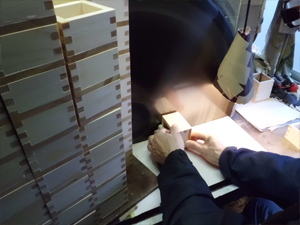
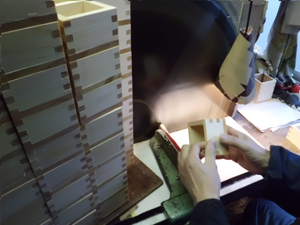
Finishing touches
In this step the masu cups are briefly put into water so that the joints get a little swollen which makes the gluing hold even better and it gives the masu cups a little gloss as well.
Then all four sides of the masu cups are planed once again equally to make them completely smooth using an even finer "planer disk".
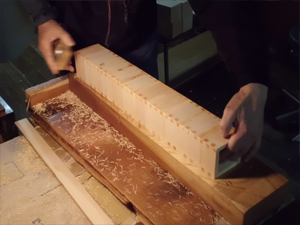
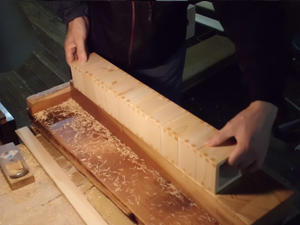
Edge shaping
The goal of this process is to make the touch of the masu cups even better so anyone who uses these cups can feel good when taking them in hand. 10 pieces of masu cups are processed at once in this step;
it’s yet again a good example for the expertise of the craftsmen manufacturing them. Since this is the final manufacturing process, the masu cups undergo a final, very throughout check before they are declared completely finished.
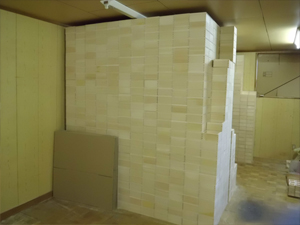
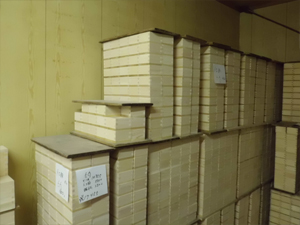
Storing
The finished wooden masu cups are stored in a cool dry place until they are shipped.
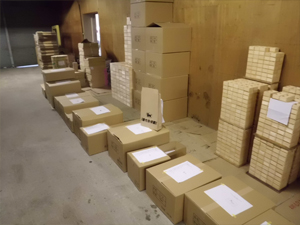
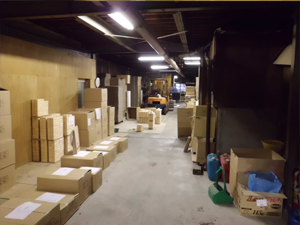
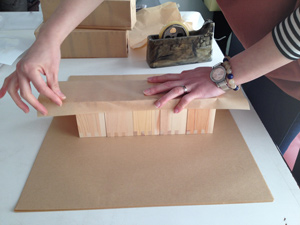
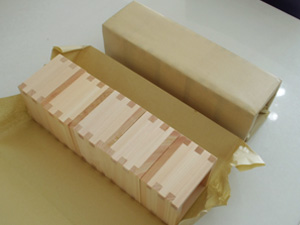
Packing
Right before shipping, every 5 piece of masu cups is wrapped in thin brown kraft wrapping paper and they are placed in a cardboard box.
For worldwide shipments the cardboard box is then placed into an even bigger cardboard box with some cushioning materials to protect the masu cups on their way to your country.
We sincerely hope that we can deliver the warmth of traditional Japanese wooden masu cups to as many customers around the globe as possible. They don’t come empty;
they are filled to the rim with the spirit of all the people who deliver them to you. Please enjoy the unique experience of MASU!
The price of the plain masu cups depends on the following factors:
# The size of the masu cups (smaller ones are cheaper, bigger ones tend to be more expensive)
# The quantity of masu cups that you would like to order
(the bigger your ordered quantity is the more discount we can give you)
# Your need for branding, if you need branding then the price depends on the number of sides you would like to get branded too
# The design of branding: it could be a custom design or one of the fix designs available from us
# Options like plastic masu bags, or paper masu boxes
# Shipping costs (based on the shipping method you have chosen)
# Payment commission fee (of the bank transfer or PayPal transfer)

The Masu selling company is shipping masu cups to customers both in Japan and worldwide. Recently we are getting more and more orders from not just individuals, but organizations, Japanese restaurants, international companies making a business opening ceremony Japanese style by opening a barrel of sake and drinking its contents from masu cups. An excellent way of drinking Japanese sake is to do it from a freshly made masu cup. That may be the reason why Japanese people cherish a rather intimate connection with these small wooden boxes from the old times. We would like to share the best parts of traditional Japanese culture with as much people around the globe as possible.
+ The glue or wood sap that has stack on the surface of the masu cups cannot be washed down with water
(both are completely harmless, so please don’t try to remove them by washing or soaking them in water)
+ Although it’s possible to disinfect the masu cups by filling them with hot water for some seconds, it’s not necessary since
Kiso hinoki has natural germicidal properties
+ If you would like to disinfect the masu cups, then do it by filling them with boiling water for some seconds right before use
+ Avoid exposing the masu cups to anything that would cause them to dry too rapidly like: direct sunlight, direct heat or any place of high temperature, fire
+ Never put the masu in a fridge, refridgerator, dishwasher, microwave oven or any oven or home appliances at all
+ Clean the masu cups with a barely wet or completely dry cloth if needed
+ If you would like to wash the masu cups, then do it with hot water in a very short time period, wipe them dry afterwards as soon as possible and let them dry completely in a well-ventilated, cool place
+ Please note that masu cups are originally meant to be used only one time, therefore due to the shrinkage or swelling of the wood by this one use, some leakage of the contents may occur on any forthcoming uses
+ Please be assured that the adhesive that is used for assembling the masu cups has no health risks if you use the cups in the way they are meant to be used
-
 Standard masu
Standard masu
Standard masu
This is the most common, standard sized masu cup. From old times, masu cups of this size are used for drinking sake on celebrations in Japan.
Since the masu cups were used for measurement as well, its name comes from the traditional
Japanese unit of go, which is equal to the volume of approximately 0.1804L = 180.4ml.
For comparison please note that a usual glass cup in Japan has a volume of about 200ml. -
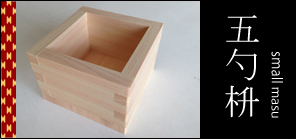 Small masu
Small masu
Small masu
Its inner volume is exactly the half of the one go masu,
which means that its inner volume is 0.09L = 90ml, rougly a mouthful of sake. Perfect for wedding ceremonies and parties of any kind.
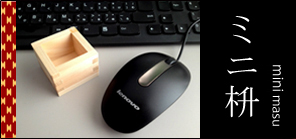 Mini masu
Mini masu
Mini masu
As its name says, it's a mini sized masu cup.
The inner volume of the mini masu is about Mini masu, which is about 0.0036L = 36ml, exactly 2 / 10th the volume of the one go wooden masu box. Its size is also equivalent to that of a regular ochoko cup, which is also traditionally used in Japan for drinking sake, therefore it's perfect for substituting ochoko cups to give you an exclusive sensation.-
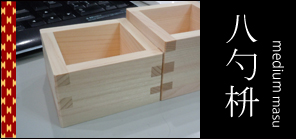 Medium masu
Medium masu
Medium masu
At first sight, the Medium masu cup looks just like a standard size, one go masu.
It's inner volume is about 0.143L = 143ml, equal to a half full standard glass cup.
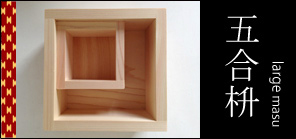 Large masu
Large masu
Large Masu
The volume of a Large Masu is roughly the same as a rice cooker. Its uses vary: measuring container, box for storing CDs and books or as a stylish wooden interior piece. A Large Masu could also be very handy on any ceremony or celebration.
You could fill it with sake to the rim, pass it around and let everyone drink from it.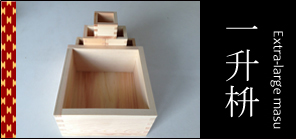 Extra-large masu
Extra-large masu
Extra-large masu
One sho is a volume unit in Japan, equal to 10 go, which means that it's 1.804L = 1800ml. It's roughly the same volume as a 2L PET bottle. In Japan sake is still sold in 1.8L bottles called one sho bottle (isshoubin) in Japanese.

